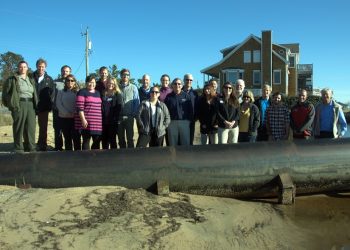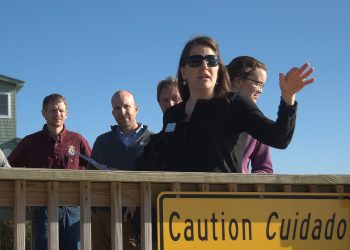The North Carolina Coastal Federation hosted a workshop on March 8 that trained local water quality professionals, planners and managers on coastal watershed restoration planning.

Participants learned about volume-reduction methods that reduce and filter polluted runoff. Photo by Todd Miller.
The workshop, titled “Watershed Planning: Strategies and Tools to Protect and Restore Coastal Water Quality,” was organized in partnership with the Albemarle-Pamlico National Estuary Partnership (APNEP) and the North Carolina Watershed Stewardship Network.
The goal of the workshop, which was held at Jockey’s Ridge State Park in Nags Head, was to help local stakeholders learn about what they can do to decrease the effect of polluted stormwater runoff on local water quality.
Each session throughout the workshop covered a chapter of the Watershed Management Planning Guidebook that was created by the federation and partners. This guidebook offers a framework for developing watershed restoration plans. It takes on a volume-reduction approach to stormwater runoff, which means using techniques that mimic the natural hydrology of a landscape.
The workshop gave participants the opportunity to learn more about tools that they can use to calculate runoff reduction volume.
“By focusing on reducing the volume of stormwater impairing our waters, we are able to better manage pollutants that are being transported in stormwater runoff through cost-effective, community-based strategies,” said Mariko Polk, GIS watershed specialist for the federation, who spoke at the workshop.
Fifty people attended the workshop. Participants ranged from engineers, academia, town representatives throughout the region and both state and federal agencies.
“The different professions represented shows that water quality is an issue of interest for a variety of stakeholders,” said Lauren Kolodij, deputy director of the federation. “Having these professionals work together toward a common goal of water quality restoration can only strengthen and streamline the effectiveness of our collaborative efforts.”

Ann Daisey, coastal conservationist, talks about the stormwater pipe at the soundside beach access. Photo by Todd Miller.
Ann Daisey, community conservationist for the federation, led the group on a field site visit to an area within the watershed where Dare Soil and Water Conservation District and the federation are developing a watershed restoration plan. A watershed restoration plan will benefit this area since Jockey’s Ridge is one of the most visited state parks in North Carolina.
During the field site visit, Daisey showed the group a stormwater pipe that was installed to deal with flooding issues. The pipe flows out near a popular swimming spot that also happens to be one of the few soundside beach accesses in the area. The waters are impaired due in part to the stormwater that flows out of the pipe.
“Jockey’s Ridge State Park is a National Natural Landmark and a popular North Carolina park, and the soundside access is widely and frequently used,” Daisey said. “Incorporating the site visit into the workshop provided an excellent conversation on methods to mitigate the stormwater pollution problem.”
Overall, the federation received a lot of positive feedback from the attendees — even one who joined from the North Carolina mountains.
“The workshop information was interesting, concise, on-time and packed full of useful material,” said Tony Hauser, an engineer for Anchor QEA of North Carolina, PLLC, of Asheville. “It will be useful to me in my own practice as we prepare similar plans here in the mountains.”
To learn more about the guidebook that the federation used as a framework for this workshop, visit nccoast.org/guidebook. For more information about the federation’s stormwater work, please contact Lauren Kolodij at 252-393-8185.
Click the button below to access materials from the March 8, 2017 workshop. The slideshows, excel tools and writing template will download as a zip file.
